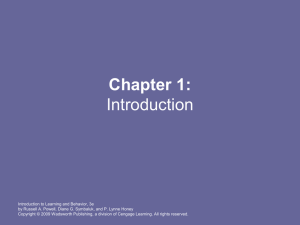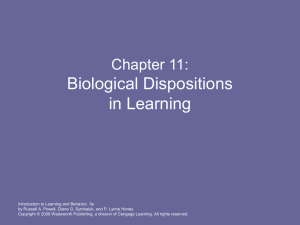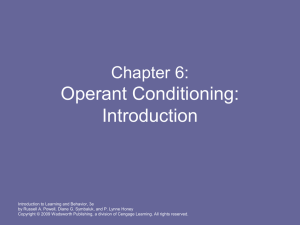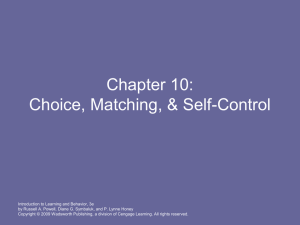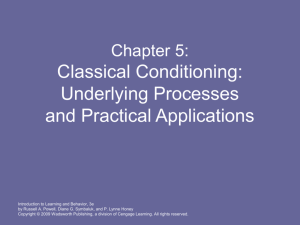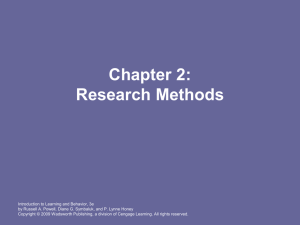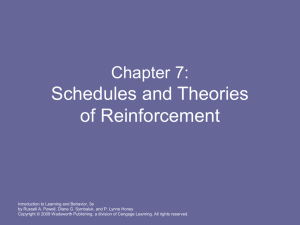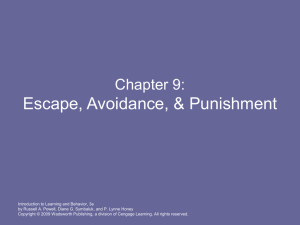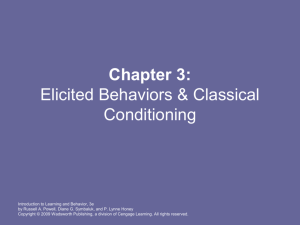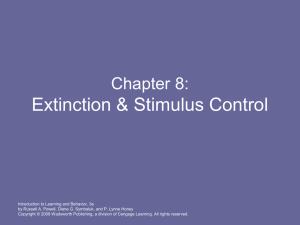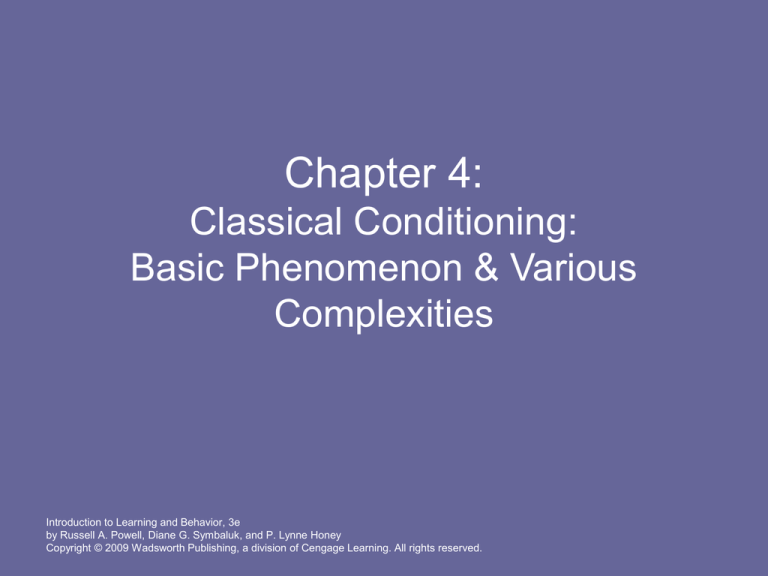
Chapter 4:
Classical Conditioning:
Basic Phenomenon & Various
Complexities
Introduction to Learning and Behavior, 3e
by Russell A. Powell, Diane G. Symbaluk, and P. Lynne Honey
Copyright © 2009 Wadsworth Publishing, a division of Cengage Learning. All rights reserved.
Acquisition
• is the process of developing and
strengthening a conditioned response
through repeated pairings of NS with US
• It proceeds rapidly during early
conditioning trials, then gradually levels
off.
• The asymptote is the maximum amount of
conditioning that can take place in a
particular situation.
Introduction to Learning and Behavior, 3e
by Russell A. Powell, Diane G. Symbaluk, and P. Lynne Honey
Copyright © 2009 Wadsworth Publishing, a division of Cengage Learning. All rights reserved.
Typical Acquisition Curve
Introduction to Learning and Behavior, 3e
by Russell A. Powell, Diane G. Symbaluk, and P. Lynne Honey
Copyright © 2009 Wadsworth Publishing, a division of Cengage Learning. All rights reserved.
What influences the speed and
asymptote of acquisition?
• Intensity of the US
• Example:
– when the US consists of a large amount of
food or a highly preferred food, conditioning is
stronger.
• Intensity of the neutral stimulus NS
• Example:
– when the NS consists of a louder metronome,
conditioning is stronger.
Introduction to Learning and Behavior, 3e
by Russell A. Powell, Diane G. Symbaluk, and P. Lynne Honey
Copyright © 2009 Wadsworth Publishing, a division of Cengage Learning. All rights reserved.
Extinction
• The Process
– a conditioned response is weakened or eliminated
when the CS is repeatedly presented in the absence
of the US.
• The Procedure
– the repeated presentation of the CS in the absence of
the US.
• Example:
– Procedure - present the metronome by itself
– Process - salivation will eventually die out
Introduction to Learning and Behavior, 3e
by Russell A. Powell, Diane G. Symbaluk, and P. Lynne Honey
Copyright © 2009 Wadsworth Publishing, a division of Cengage Learning. All rights reserved.
Notation for Extinction
Metronome: Food Salivation
NS
US
UR
Metronome Salivation
CS
CR
Metronome No salivation
“NS”
—
Introduction to Learning and Behavior, 3e
by Russell A. Powell, Diane G. Symbaluk, and P. Lynne Honey
Copyright © 2009 Wadsworth Publishing, a division of Cengage Learning. All rights reserved.
What happens to the CR?
• It has decreased in strength.
• It has not been completely eliminated.
• It can be reacquired quite rapidly when the
CS (or NS) is again paired with the US.
• Example:
– pair the metronome with food following an
extinction procedure
Introduction to Learning and Behavior, 3e
by Russell A. Powell, Diane G. Symbaluk, and P. Lynne Honey
Copyright © 2009 Wadsworth Publishing, a division of Cengage Learning. All rights reserved.
Spontaneous Recovery
• the reappearance of a CS following a rest period
after extinction.
• An extinguished response can reappear even in
the absence of further pairings between the CS
and US.
• Each time the response recovers it is somewhat
weaker and is extinguished more quickly than
before.
• Example:
– after several extinction sessions, the metronome will
elicit little or no salivation.
Introduction to Learning and Behavior, 3e
by Russell A. Powell, Diane G. Symbaluk, and P. Lynne Honey
Copyright © 2009 Wadsworth Publishing, a division of Cengage Learning. All rights reserved.
Spontaneous Recovery Graph
Introduction to Learning and Behavior, 3e
by Russell A. Powell, Diane G. Symbaluk, and P. Lynne Honey
Copyright © 2009 Wadsworth Publishing, a division of Cengage Learning. All rights reserved.
Learning Something New
• Extinction is not simply a process of unlearning
the conditioning.
• Extinction involves learning something new.
• New conditioning inhibits the occurrence of the
CR in the presence of the CS.
• Example:
– The dog learns to inhibit the response of salivation to
the metronome.
Introduction to Learning and Behavior, 3e
by Russell A. Powell, Diane G. Symbaluk, and P. Lynne Honey
Copyright © 2009 Wadsworth Publishing, a division of Cengage Learning. All rights reserved.
Disinhibition
• the sudden recovery of a response during an
extinction procedure when a novel stimulus is
introduced.
• Example:
– If after extinction we present a novel humming noise,
the metronome may again elicit salivation.
– If your anxiety while giving a speech gradually fades,
it may suddenly recover when a noisy fan starts.
Introduction to Learning and Behavior, 3e
by Russell A. Powell, Diane G. Symbaluk, and P. Lynne Honey
Copyright © 2009 Wadsworth Publishing, a division of Cengage Learning. All rights reserved.
Stimulus Generalization
• the tendency for a CR to occur in the presence
of a stimulus that is similar to the CS.
• The more similar the stimulus is to the original
CS, the stronger the response.
• It is an important evolutionary adaptation.
• Example:
– If we learn to fear a poisonous spider, it is far more
adaptive to learn to fear other spiders as well,
particularly those spiders that look similar to the one
that bit us.
Introduction to Learning and Behavior, 3e
by Russell A. Powell, Diane G. Symbaluk, and P. Lynne Honey
Copyright © 2009 Wadsworth Publishing, a division of Cengage Learning. All rights reserved.
Semantic Generalization
• the generalization of a CS to verbal stimuli
that are similar in meaning to the CS.
• The meaning of the word is critical.
• Example:
– Car and automotive, vehicle, etc. elicit a
similar response, while tar and bar do not
Introduction to Learning and Behavior, 3e
by Russell A. Powell, Diane G. Symbaluk, and P. Lynne Honey
Copyright © 2009 Wadsworth Publishing, a division of Cengage Learning. All rights reserved.
Stimulus Discrimination
• the tendency for a response to be elicited
more by one stimulus than another.
• Example:
– The dog salivates in the presence of the
2,000-Hz tone but not in the presence of a
1,900-Hz tone.
• This can be deliberately trained through
discrimination training.
Introduction to Learning and Behavior, 3e
by Russell A. Powell, Diane G. Symbaluk, and P. Lynne Honey
Copyright © 2009 Wadsworth Publishing, a division of Cengage Learning. All rights reserved.
Discrimination Training
Conditioning Phase
2,000-Hz tone: Food Salivation
NS
US
UR
1,900-Hz tone: No food No Salivation
NS
—
Test Phase
2,000-Hz tone Salivation
CS+
CR
1,900-Hz tone No salivation
CS—
Introduction to Learning and Behavior, 3e
by Russell A. Powell, Diane G. Symbaluk, and P. Lynne Honey
Copyright © 2009 Wadsworth Publishing, a division of Cengage Learning. All rights reserved.
Discrimination
• The 2,000-Hz tone has become an
excitatory CS (or CS+).
• It predicts the presentation of food.
• The 1,900-Hz tone has become an
inhibitory CS (or CS–).
• It predicts the absence of food.
Introduction to Learning and Behavior, 3e
by Russell A. Powell, Diane G. Symbaluk, and P. Lynne Honey
Copyright © 2009 Wadsworth Publishing, a division of Cengage Learning. All rights reserved.
Development of Disorders
• Phobias - overgeneralization of a fear response.
• Example:
– A woman who overgeneralizes her fear of an abusive
relationship may develop a fear of all relationships.
• Experimental Neurosis - neurotic-like symptoms
which develop when exposed to extreme
uncertainty.
• Example:
– Jana’s boyfriends display neuroticism after her erratic
behavior.
Introduction to Learning and Behavior, 3e
by Russell A. Powell, Diane G. Symbaluk, and P. Lynne Honey
Copyright © 2009 Wadsworth Publishing, a division of Cengage Learning. All rights reserved.
Extroversion - Introversion
Introverts
• are highly reactive to external stimulation
• condition easily
• develop anxiety-type symptoms in reaction to stress
Extroverts
• less reactive to external stimulation
• condition less easily
• develop physical-type symptoms in reaction to stress
Introduction to Learning and Behavior, 3e
by Russell A. Powell, Diane G. Symbaluk, and P. Lynne Honey
Copyright © 2009 Wadsworth Publishing, a division of Cengage Learning. All rights reserved.
Higher-Order Conditioning
• stimulus that is associated with a CS can
also become a CS.
• Example:
– Wasp - Trash Can
Introduction to Learning and Behavior, 3e
by Russell A. Powell, Diane G. Symbaluk, and P. Lynne Honey
Copyright © 2009 Wadsworth Publishing, a division of Cengage Learning. All rights reserved.
Wasp - Trashcan Example
Wasp: Sting Fear
NS1 US
UR
Wasp Fear
CS1
CR
Trashcan: Wasp Fear
NS2
CS1
CR
Trashcan Fear
CS2
CR
Introduction to Learning and Behavior, 3e
by Russell A. Powell, Diane G. Symbaluk, and P. Lynne Honey
Copyright © 2009 Wadsworth Publishing, a division of Cengage Learning. All rights reserved.
Third-Order Conditioning
• pairing third stimulus with the CS.
• It is difficult to obtain.
• The conditioned response to a third-order
conditioned stimulus (the CS3) is likely to
be very weak.
• Example:
– Advertising – an attractive woman in a dress
Introduction to Learning and Behavior, 3e
by Russell A. Powell, Diane G. Symbaluk, and P. Lynne Honey
Copyright © 2009 Wadsworth Publishing, a division of Cengage Learning. All rights reserved.
Sensory Preconditioning
• when one stimulus is conditioned as a CS,
another stimulus it was previously associated
with can also become a CS.
• Example:
– The toolshed was previously associated with wasps.
Toolshed: Wasps
NS2
NS1
Introduction to Learning and Behavior, 3e
by Russell A. Powell, Diane G. Symbaluk, and P. Lynne Honey
Copyright © 2009 Wadsworth Publishing, a division of Cengage Learning. All rights reserved.
How does the toolshed elicit fear?
Wasp: Sting Fear
NS1 US
UR
Wasp Fear
CS1
CR
Toolshed Fear
CS2
CR
Introduction to Learning and Behavior, 3e
by Russell A. Powell, Diane G. Symbaluk, and P. Lynne Honey
Copyright © 2009 Wadsworth Publishing, a division of Cengage Learning. All rights reserved.
What impacts sensory
preconditioning?
• The response elicited by the toolshed
(CS2) is generally weaker than the
response elicited by the wasps (CS1).
• This type of conditioning works best if the
stimuli are paired relatively few times.
• Sometimes works better if stimuli are
presented simultaneously as opposed to
sequentially.
Introduction to Learning and Behavior, 3e
by Russell A. Powell, Diane G. Symbaluk, and P. Lynne Honey
Copyright © 2009 Wadsworth Publishing, a division of Cengage Learning. All rights reserved.
Compound Stimulus
• simultaneous presentation of two or more
individual stimuli
• Example:
– The sound of a metronome is presented at
the same time as a light.
• Two Types:
– Overshadowing
– Blocking
Introduction to Learning and Behavior, 3e
by Russell A. Powell, Diane G. Symbaluk, and P. Lynne Honey
Copyright © 2009 Wadsworth Publishing, a division of Cengage Learning. All rights reserved.
Overshadowing
• the most salient member of a compound
stimulus is more readily conditioned as a
CS and thereby interferes with
conditioning of the least salient member.
• Example:
– assigning an assistant to announce an
unpopular decision
– a bright light and a faint-sounding metronome
Introduction to Learning and Behavior, 3e
by Russell A. Powell, Diane G. Symbaluk, and P. Lynne Honey
Copyright © 2009 Wadsworth Publishing, a division of Cengage Learning. All rights reserved.
Notation for Overshadowing
[Bright light + Faint metronome]: Food Salivation
NS
US
UR
[Bright light + Faint metronome] Salivation
CS
CR
Bright light Salivation
CS
CR
Faint metronome No salivation
NS
—
Introduction to Learning and Behavior, 3e
by Russell A. Powell, Diane G. Symbaluk, and P. Lynne Honey
Copyright © 2009 Wadsworth Publishing, a division of Cengage Learning. All rights reserved.
Blocking
• the presence of an established CS
interferes with conditioning of a new CS.
• consists of a neutral stimulus and a CS
rather than two neutral stimuli
(overshadowing) that differ in salience.
• Example:
– When announcing bad news, announce with
another manager who is already disliked by
the employees.
Introduction to Learning and Behavior, 3e
by Russell A. Powell, Diane G. Symbaluk, and P. Lynne Honey
Copyright © 2009 Wadsworth Publishing, a division of Cengage Learning. All rights reserved.
Latent Inhibition
• an unfamiliar stimulus is more readily
conditioned than a familiar stimulus.
• Example:
– a rabbit in a grassy field is attacked by a
coyote
– the scent of the coyote is a good predictor of
a possible attack, not the scent of the grass
• People with schizophrenia display less
latent inhibition than is normal.
Introduction to Learning and Behavior, 3e
by Russell A. Powell, Diane G. Symbaluk, and P. Lynne Honey
Copyright © 2009 Wadsworth Publishing, a division of Cengage Learning. All rights reserved.
Temporal Conditioning
• a form of classical conditioning in which
the CS is the passage of time.
• Example:
– anxiety in residents who experience a
bombing attack each night at 2:00 a.m. for
several nights
– feeling hungry at noon
Introduction to Learning and Behavior, 3e
by Russell A. Powell, Diane G. Symbaluk, and P. Lynne Honey
Copyright © 2009 Wadsworth Publishing, a division of Cengage Learning. All rights reserved.
Occasion Setting
• a procedure in which a stimulus (i.e., an
occasion setter) signals that a CS is likely to be
followed by the US with which it is associated.
• The context of the conditioning often comes to
serve as an overall predictor of the relationship
between two events.
• Example:
– Alcohol absent { Parents: Mild abuse Mild anxiety
– Alcohol present { Parents: Severe abuse Strong
anxiety
Introduction to Learning and Behavior, 3e
by Russell A. Powell, Diane G. Symbaluk, and P. Lynne Honey
Copyright © 2009 Wadsworth Publishing, a division of Cengage Learning. All rights reserved.
External Inhibition
• the presentation of a novel stimulus at the
same time as the CS produces a decrease
in the strength of the CS.
• Example:
– present a light at the same time as the
metronome
– the dog has been distracted by the light and
therefore reacts less strongly to the
metronome.
Introduction to Learning and Behavior, 3e
by Russell A. Powell, Diane G. Symbaluk, and P. Lynne Honey
Copyright © 2009 Wadsworth Publishing, a division of Cengage Learning. All rights reserved.
US Revaluation
• postconditioning presentation of the US at a
different level of intensity, thereby altering the
strength of response to the previously
conditioned CS.
• The value or magnitude of the US is changed.
• The intensity of response is dependent on the
animal’s most recent experience with the US.
• Example:
– Giving the dog more food after conditioning it with
less
Introduction to Learning and Behavior, 3e
by Russell A. Powell, Diane G. Symbaluk, and P. Lynne Honey
Copyright © 2009 Wadsworth Publishing, a division of Cengage Learning. All rights reserved.
Pseudoconditioning
• an elicited response that appears to be a CR is
actually the result of sensitization rather than
conditioning.
• Example:
– pair of the light with the shock, so that dog’s leg
flexion is elicited by light
• Sensitization can result in the response being
elicited by other stimuli as well.
• This is a potential problem whenever the US is
some type of emotionally arousing stimulus.
Introduction to Learning and Behavior, 3e
by Russell A. Powell, Diane G. Symbaluk, and P. Lynne Honey
Copyright © 2009 Wadsworth Publishing, a division of Cengage Learning. All rights reserved.
Summary
• Strengthening a conditioned response by pairing
a CS (or NS) with a US is known as acquisition.
• Weakening a conditioned response by
repeatedly presenting the CS by itself is known
as extinction.
• Spontaneous recovery is the reappearance of a
previously extinguished response after a rest
period.
• Disinhibition is the sudden recovery of an
extinguished response following introduction of a
novel stimulus.
Introduction to Learning and Behavior, 3e
by Russell A. Powell, Diane G. Symbaluk, and P. Lynne Honey
Copyright © 2009 Wadsworth Publishing, a division of Cengage Learning. All rights reserved.
Summary, continued
• Stimulus Generalization vs. Stimulus
Discrimination
• Semantic Generalization
• Higher-order conditioning
• Sensory preconditioning
• Temporal conditioning
• Occasion setting
Introduction to Learning and Behavior, 3e
by Russell A. Powell, Diane G. Symbaluk, and P. Lynne Honey
Copyright © 2009 Wadsworth Publishing, a division of Cengage Learning. All rights reserved.
Summary, continued
• US revaluation
• Pseudoconditioning
• Processes that interfere with conditioning:
– overshadowing
– blocking
– latent inhibition
– external inhibition
Introduction to Learning and Behavior, 3e
by Russell A. Powell, Diane G. Symbaluk, and P. Lynne Honey
Copyright © 2009 Wadsworth Publishing, a division of Cengage Learning. All rights reserved.

